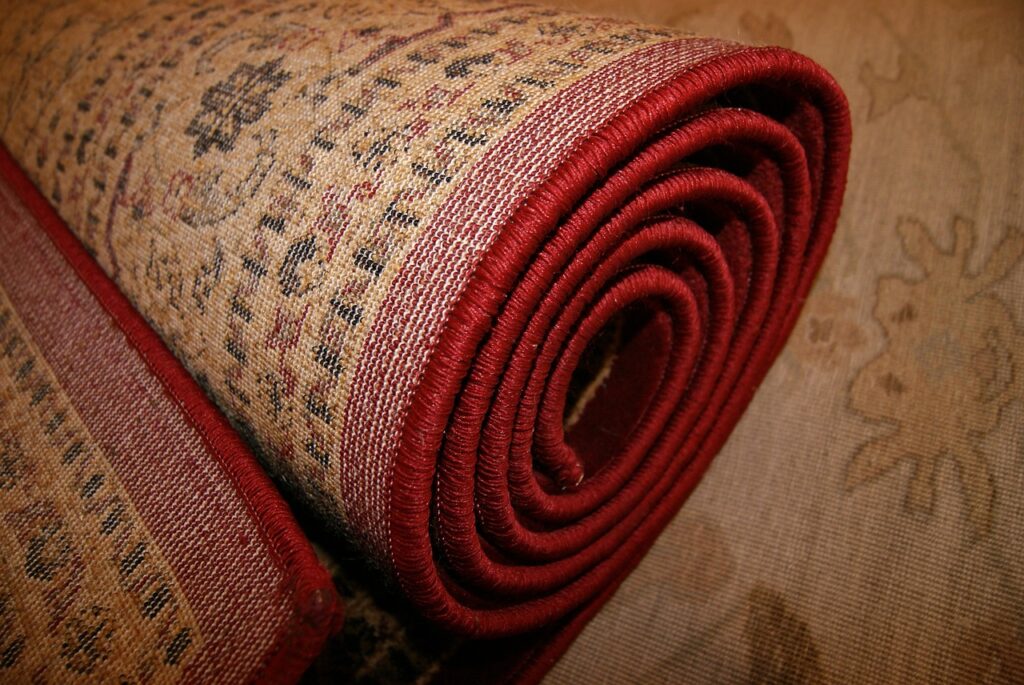Introduction
There are several carpet cleaning methods, each with its own set of advantages and disadvantages. The choice of cleaning method depends on factors such as the type of carpet, the level of dirt or stains, the available equipment, and the desired level of cleaning. It also depends on the where the carpet has been installed e.g. in the living area or on the stairs with railings. This article introduces some common carpet cleaning methods and their characteristics.

1. Steam Cleaning (Hot Water Extraction):
- Method: A cleaning solution is sprayed onto the carpet, followed by hot water extraction. A powerful machine vacuums up the solution along with dirt and debris.
- Suitable For: Deep cleaning, removing dirt, allergens, and stains.
- Advantages: Effective in removing deep-seated dirt and stains. High-temperature steam can kill dust mites and bacteria.
- Disadvantages: Longer drying time compared to other methods. Improper drying can lead to mold growth.
2. Dry Carpet Cleaning:
- Method: Absorbent compounds or cleaning powders are spread on the carpet, agitated, and then vacuumed.
- Suitable For: Quick cleaning with minimal drying time. Ideal for carpets that can’t handle moisture.
- Advantages: Quick drying, no risk of mold growth. Can be done without specialized equipment.
- Disadvantages: May not be as effective for deep cleaning. Residues from cleaning powders can build up over time.
3. Bonnet Cleaning (Dry Cleaning):
- Method: A cleaning solution is applied to the carpet, and a rotary machine with an absorbent pad is used to scrub and absorb dirt.
- Suitable For: Surface-level cleaning, often used in commercial settings with heavy foot traffic.
- Advantages: Quick drying time. Good for routine maintenance.
- Disadvantages: Only cleans the surface of the carpet. Dirt can be pushed deeper into the fibers.
4. Shampooing:
- Method: A foamy shampoo solution is applied to the carpet and then agitated with a rotary brush. The solution is vacuumed up along with dirt.
- Suitable For: Older carpets with heavy dirt or stains.
- Advantages: Effective in removing stains and dirt from heavily soiled carpets.
- Disadvantages: Leaves behind a residue that can attract more dirt. Requires thorough rinsing, which may not always be achieved.

5. Encapsulation Cleaning:
- Method: A polymer-based cleaning solution is applied to the carpet. As it dries, it forms crystals around dirt particles, which are then vacuumed up.
- Suitable For: Routine maintenance, commercial settings.
- Advantages: Low moisture, quick drying time. Dirt is encapsulated and easily vacuumed.
- Disadvantages: May not be as effective for deep cleaning, especially for heavily soiled carpets.
6. DIY Carpet Cleaners:
- Method: Rental or home carpet cleaning machines use a combination of cleaning solutions and water extraction.
- Suitable For: Light cleaning and spot removal between professional cleanings.
- Advantages: Convenient for small areas or spot cleaning.
- Disadvantages: May not be as powerful as professional equipment. Inadequate cleaning can lead to over-wetting and mold growth if not done properly.
Summary
Each carpet cleaning method has its own strengths and weaknesses. The choice of method should be based on factors like the carpet’s condition, the desired level of cleanliness, and the recommendations of professionals. Regular vacuuming and professional cleaning can help extend the life of your carpet and maintain a clean and healthy indoor environment.
